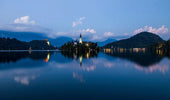A Photographer’s Guide to Croatia: Exploring Rovinj, Plitvice Lakes, and Beyond

A Photographer’s Guide to Croatia: Exploring Rovinj, Plitvice Lakes, and Beyond
With its breathtaking coastal vistas, historic towns, and serene lakes, Croatia is a dream destination for photographers seeking diverse and captivating landscapes. From the pastel hues of Rovinj’s sunrise to the cascading waterfalls of Plitvice Lakes, this guide offers insights into the best locations, lenses, and techniques to capture the magic of this remarkable country.
Rovinj: A Coastal Gem for Seascape Photography
Rovinj, a picturesque coastal town on the Istrian Peninsula, offers endless photographic opportunities. The charming skyline, punctuated by the iconic St. Euphemia Church, is best captured during the golden and blue hours.
When to Shoot:
For the best results, head out before sunrise. The early morning provides soft, pastel tones of pink and purple in the sky, creating a tranquil atmosphere that complements the warm lights illuminating the town. Sunset is another option, but it often brings a harsher orange glow that can overpower the scene.
Lens Choices and Compositions:
- Telephoto Lens (70-200mm or similar): Use this to zoom in on the town’s details. A focal length of around 130mm isolates the church and surrounding buildings while leaving enough negative space to emphasize the island setting.
- Wide-Angle Lens (16-35mm): Ideal for capturing the entire skyline and reflections in the water. Position yourself on the shoreline opposite the town for the best vantage point.
- Filters: A soft graduated neutral density (ND) filter helps balance the exposure between the sky and the water. Use it as a weak ND filter for slightly longer exposures, smoothing out the water’s surface.
Pro Tip: Avoid using a polarizer when clouds are present, as it can remove their texture and depth. Experiment with underexposing by half to one-and-a-half stops to control glare and retain details in bright areas.
Mastering Panoramas in Rovinj
Panoramic photography is a powerful technique for capturing the breadth and detail of Rovinj’s skyline. Telephoto panoramas are particularly effective, allowing you to stitch multiple zoomed-in shots into a seamless, detailed image.
How to Create a Telephoto Panorama:
- Setup: Use a sturdy tripod to keep your camera level. Ensure your ball head or panoramic head allows smooth horizontal movement.
- Overlap: Ensure at least 25% overlap between each shot to help stitching software align the images accurately.
- Shutter Speed: Use a 1.6-second exposure to slightly soften the water while keeping elements like boats sharp.
Editing Workflow: Process your RAW files in Camera Raw or Lightroom first, then stitch them in Photoshop. Save the final stitched image as a TIFF for optimal quality before making final adjustments.
Plitvice Lakes: A Paradise for Landscape Photographers
Plitvice Lakes National Park is a UNESCO World Heritage Site renowned for its interconnected lakes and cascading waterfalls. The area’s vibrant greenery, still waters, and misty cascades create compositions straight out of a fairytale.
When to Shoot:
The park opens early, but late afternoon is ideal for quieter conditions. Most visitors leave by 5 PM, allowing you to explore with fewer crowds. Official closing times vary, but lingering past peak hours often provides the best lighting and solitude.
Lens Choices and Compositions:
- Wide-Angle Lens: Capture expansive scenes of lakes and waterfalls. Incorporate reflections of trees and hills to add depth.
- Telephoto Lens: Isolate details like smaller waterfalls or reflections. This lens also helps capture layers within the landscape, adding depth.
Challenges:
Many of the best vantage points are on bouncy walkways. This makes long exposures difficult when others are around. To combat this, use faster shutter speeds or visit during less crowded times.
Essential Tips for Shooting in Croatia
- Glare Management: Croatia’s coastal and lake scenes often have intense glare. Experiment with slightly underexposing your shots and using ND filters to maintain control.
- Foreground Elements: While including foreground elements like rocks is tempting, ensure they don’t detract from the main focal point, especially in seascapes like Rovinj. For Plitvice, use reflections and natural lines to guide the viewer’s eye.
- Editing on the Go: Managing storage on a road trip can be challenging. Use external drives or cloud storage to free up space for your RAW files. Edit minimally on location to save time and focus on shooting.
- Crowd Avoidance: Popular locations like Plitvice and coastal towns can get busy. Arrive early or stay late to make the most of the light and avoid crowds.
Beyond Rovinj and Plitvice: Hidden Gems
While Rovinj and Plitvice Lakes are iconic, Croatia offers countless other photographic treasures. Consider exploring:
- Coastal Villages: Small villages built into rocky coastlines provide unique compositions. Look for natural ravines and estuaries for dramatic sunrise shots.
-
Waterfalls: Croatia’s waterfalls, with their varying elevations and lush surroundings, are ideal for detailed shots. Use a medium shutter speed to capture motion while retaining texture.
Local map of Rovinj
Croatia is a photographer’s playground, blending historic charm, natural beauty, and endless creative possibilities. Whether capturing the tranquil colours of Rovinj’s sunrise, the intricate details of Plitvice’s waterfalls, or crafting panoramic masterpieces, this guide ensures you’re equipped to make the most of your journey. Pack your lenses, filters, and tripod, and immerse yourself in the art of photography amidst Croatia’s stunning landscapes.
Meet the Author:
I am a Devon based photographer, who enjoys travel, hiking, rugby and photographing the beautiful world in which we live in, I see photography as a creative expression upon visiting beautiful places. Each picture often tells a story.
Thank you for reading this article, please feel to share it with your friends and please check out all my photography - Wall Art and Framed Prints and our Croatian Landscape Shots
Thanks
Sebastien Coell Photography




